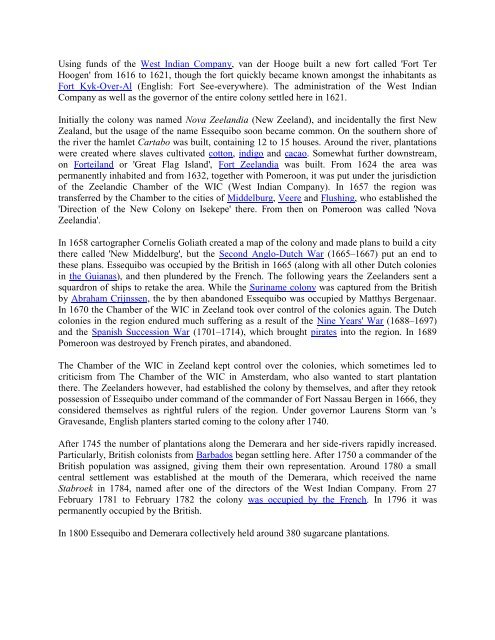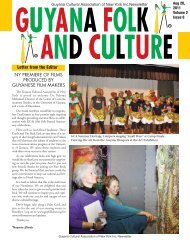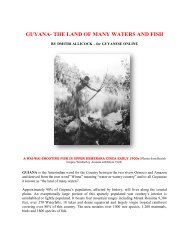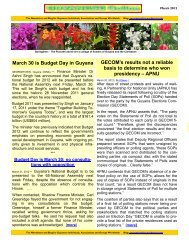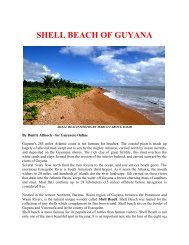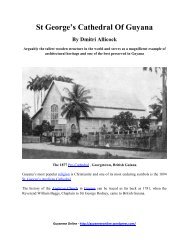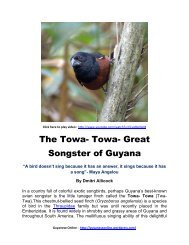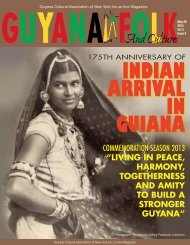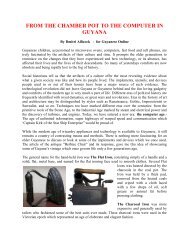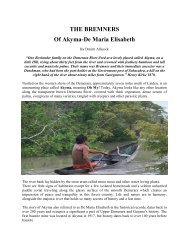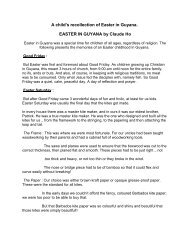Remnants Of The Early Dutch in Guyana 1616 ... - Guyanese Online
Remnants Of The Early Dutch in Guyana 1616 ... - Guyanese Online
Remnants Of The Early Dutch in Guyana 1616 ... - Guyanese Online
You also want an ePaper? Increase the reach of your titles
YUMPU automatically turns print PDFs into web optimized ePapers that Google loves.
Us<strong>in</strong>g funds of the West Indian Company, van der Hooge built a new fort called 'Fort Ter<br />
Hoogen' from <strong>1616</strong> to 1621, though the fort quickly became known amongst the <strong>in</strong>habitants as<br />
Fort Kyk-Over-Al (English: Fort See-everywhere). <strong>The</strong> adm<strong>in</strong>istration of the West Indian<br />
Company as well as the governor of the entire colony settled here <strong>in</strong> 1621.<br />
Initially the colony was named Nova Zeelandia (New Zeeland), and <strong>in</strong>cidentally the first New<br />
Zealand, but the usage of the name Essequibo soon became common. On the southern shore of<br />
the river the hamlet Cartabo was built, conta<strong>in</strong><strong>in</strong>g 12 to 15 houses. Around the river, plantations<br />
were created where slaves cultivated cotton, <strong>in</strong>digo and cacao. Somewhat further downstream,<br />
on Forteiland or 'Great Flag Island', Fort Zeelandia was built. From 1624 the area was<br />
permanently <strong>in</strong>habited and from 1632, together with Pomeroon, it was put under the jurisdiction<br />
of the Zeelandic Chamber of the WIC (West Indian Company). In 1657 the region was<br />
transferred by the Chamber to the cities of Middelburg, Veere and Flush<strong>in</strong>g, who established the<br />
'Direction of the New Colony on Isekepe' there. From then on Pomeroon was called 'Nova<br />
Zeelandia'.<br />
In 1658 cartographer Cornelis Goliath created a map of the colony and made plans to build a city<br />
there called 'New Middelburg', but the Second Anglo-<strong>Dutch</strong> War (1665–1667) put an end to<br />
these plans. Essequibo was occupied by the British <strong>in</strong> 1665 (along with all other <strong>Dutch</strong> colonies<br />
<strong>in</strong> the Guianas), and then plundered by the French. <strong>The</strong> follow<strong>in</strong>g years the Zeelanders sent a<br />
squardron of ships to retake the area. While the Sur<strong>in</strong>ame colony was captured from the British<br />
by Abraham Crijnssen, the by then abandoned Essequibo was occupied by Matthys Bergenaar.<br />
In 1670 the Chamber of the WIC <strong>in</strong> Zeeland took over control of the colonies aga<strong>in</strong>. <strong>The</strong> <strong>Dutch</strong><br />
colonies <strong>in</strong> the region endured much suffer<strong>in</strong>g as a result of the N<strong>in</strong>e Years' War (1688–1697)<br />
and the Spanish Succession War (1701–1714), which brought pirates <strong>in</strong>to the region. In 1689<br />
Pomeroon was destroyed by French pirates, and abandoned.<br />
<strong>The</strong> Chamber of the WIC <strong>in</strong> Zeeland kept control over the colonies, which sometimes led to<br />
criticism from <strong>The</strong> Chamber of the WIC <strong>in</strong> Amsterdam, who also wanted to start plantation<br />
there. <strong>The</strong> Zeelanders however, had established the colony by themselves, and after they retook<br />
possession of Essequibo under command of the commander of Fort Nassau Bergen <strong>in</strong> 1666, they<br />
considered themselves as rightful rulers of the region. Under governor Laurens Storm van 's<br />
Gravesande, English planters started com<strong>in</strong>g to the colony after 1740.<br />
After 1745 the number of plantations along the Demerara and her side-rivers rapidly <strong>in</strong>creased.<br />
Particularly, British colonists from Barbados began settl<strong>in</strong>g here. After 1750 a commander of the<br />
British population was assigned, giv<strong>in</strong>g them their own representation. Around 1780 a small<br />
central settlement was established at the mouth of the Demerara, which received the name<br />
Stabroek <strong>in</strong> 1784, named after one of the directors of the West Indian Company. From 27<br />
February 1781 to February 1782 the colony was occupied by the French. In 1796 it was<br />
permanently occupied by the British.<br />
In 1800 Essequibo and Demerara collectively held around 380 sugarcane plantations.


